Photo albums from this trip (more photos than shown on this page) are here.
In July 2009, I spent 3 weeks in South America, visiting parts of Venezuela and Peru. Had a wonderful time. The reason for this trip, and its timing, was the wedding of two friends in Caracas on the 18th. I was honoured to be invited, and indeed was the only person there who was not related to either the bride or the groom.
I left home (Townsville) on 8 July. Stayed overnight in Brisbane at an inexpensive hotel (Soho) in Spring Hill, where I’ve often stayed. Free wifi, good restaurant on the site. After hotel checkin, I walked into town to Pulp Fiction bookshop, for the exercise.
The next morning (9 July), I had to catch a shuttle before breakfast time at the hotel, but after checkin and security (both quick, no dramas) at the international airport, I headed for the Qantas Club, which had a nice spread of fruit, toast, and other breakfast foods. (Minor perk of having a Business Class ticket.) Plus of course free internet, both wifi and their own machines. I had brought with me only my iPod Touch, so I mainly used others’ computers when I had the chance, but often picked up my email on the iPod when free wifi was available.
I flew on Qantas to Auckland, then changed to LAN to go on to Santiago de Chile. Business Class on both flights was far from full, and I think Economy wasn’t either, at least on the Auckland-to-Santiago leg. My ticket was booked through LAN, which charged me about 2/3 of what Qantas was charging for the same flight, on the same planes.
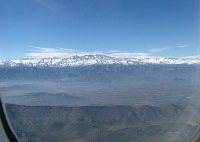 Coming in to Santiago we flew between the high, snow-covered Andes and the old, weathered, eroded coastal range. I was on the wrong side of the plane for taking photos of the Andes; by the time the plane turned to land we were low into smog.
Coming in to Santiago we flew between the high, snow-covered Andes and the old, weathered, eroded coastal range. I was on the wrong side of the plane for taking photos of the Andes; by the time the plane turned to land we were low into smog.
Airport arrivals area was not very busy, so I got through immigration and customs (and the place where one pays one’s entry tax) very quickly. Spotted the guide (with my name on a sign) easily. On the drive to the Hotel Galerias, he delivered a detailed commentary on Chilean history and culture, personal safety for tourists, and a range of other topics that I’ve forgotten. Although I had slept on the plane, I was tired, so I did little except shower, nap, and go to dinner in the hotel’s very good restaurant.
Next day (10 July), once again I had to leave the hotel before breakfast (which was included in the room rate). Some hotels will provide a take-away continental breakfast, but this one didn’t. The car whisked me to the airport, where there was a long, daunting checkin queue for Economy. The guide seemed a bit startled when I said I was in Business Class (and apologised for not asking), but then led me to the opposite end of the checkin hall to the small area for “preferential” passengers, where only a half dozen or so people were waiting. Security check here was conspicuously slack compared to other security checks I’ve endured. Don’t know if that is typical of this airport or just in the “Preferential” section.
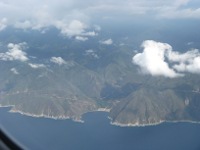 Fortunately I was able to get some breakfast in the LAN Business Class lounge before the almost-full flight to Caracas. I got some photos of the Andes after take-off, then napped, had lunch, and photoÂgraphed the Venezuelan coastline as we came in to the Caracas MaiquetÃa International Airport (Simón BolÃvar). The city of Caracas itself is in a high valley surrounded by mountains, with the airport on the small flat coastal area at the base of the mountains. The contrast in temperature and humidity at the coast (high) and in the city (pleasant) was dramatic. It was, after all, high summer in the tropics.
Fortunately I was able to get some breakfast in the LAN Business Class lounge before the almost-full flight to Caracas. I got some photos of the Andes after take-off, then napped, had lunch, and photoÂgraphed the Venezuelan coastline as we came in to the Caracas MaiquetÃa International Airport (Simón BolÃvar). The city of Caracas itself is in a high valley surrounded by mountains, with the airport on the small flat coastal area at the base of the mountains. The contrast in temperature and humidity at the coast (high) and in the city (pleasant) was dramatic. It was, after all, high summer in the tropics.
The immigration hall was chaos. Many planes had arrived at around the same time; the hall was packed with people. Most of the immigration booths were open, but the queues were moving very slowly. An hour or so later, I got past immigration, found my bag, went through customs quickly, and emerged into a space full of aggressive taxi touts. I soon heard a familiar voice shouting my name, and was collected by D, who took me to the place where other members of our group were waiting. S’s relatives had arrived from Germany not long before me.
We all piled into two large vehicles and set off into heavy traffic: several lanes of slow-moving, mostly large (4WD size) vehicles, with motorcycles zipping along between the cars, crept up the mountain to the city. At the numerous places where traffic slowed to a stop, roadside vendors would dart into the traffic, selling food, water, soft drinks, newspapers, souvenirs, and probably lottery tickets. I don’t know what you did if you needed a toilet!
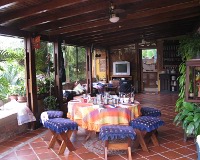 Over two hours later (a faster trip than on many occasions, I was told), we arrived at the home of one of D’s uncles, where other relatives began gathering. Later in the evening we partook of a superb barbecue prepared by family members. This apartment is a tropical style place with a large verandah open to the breeze, in a gated and guarded community. The bars on the front door were quite impressive.
Over two hours later (a faster trip than on many occasions, I was told), we arrived at the home of one of D’s uncles, where other relatives began gathering. Later in the evening we partook of a superb barbecue prepared by family members. This apartment is a tropical style place with a large verandah open to the breeze, in a gated and guarded community. The bars on the front door were quite impressive.
The next morning (Saturday, 11 July), three cars (driven by members of the family) set off for Tucacas, a seaside resort area to the west. Heavy traffic, road mostly in poor repair, speed limit low, several stops where National Guard personnel (with rifles) were checking vehicles. Mostly they just waved us through.
On our way, we were joined by two more cars full of relatives, coming from other parts of the area. As we drove along, they coordinated their convoy by mobile phone (mostly text messages). I wonder how they did this before mobile phones became common.
Petrol costs around 11 cents a litre, since VeneÂzuela is a petroleum-producing nation. No wonder people can drive gas-guzzlers. We also saw a lot of old, often dilapidated and overloaded minibuses, and pickup trucks with people sitting in the back.
 We stopped once for a toilet break (bring your own paper; each car had a roll) and once for breakÂfast at a streetside vendor’s stall, before arriving at Chichiriviche, a seaside town not far from Tucacas. Turns out that D’s mother had been unable to get us all into a resort as intended, so we were in a multi-bedroom place that reminded me of some outback accommodation in Australia. The rooms did at least have ensuite toilet/shower rooms, though they were unventilated.
We stopped once for a toilet break (bring your own paper; each car had a roll) and once for breakÂfast at a streetside vendor’s stall, before arriving at Chichiriviche, a seaside town not far from Tucacas. Turns out that D’s mother had been unable to get us all into a resort as intended, so we were in a multi-bedroom place that reminded me of some outback accommodation in Australia. The rooms did at least have ensuite toilet/shower rooms, though they were unventilated.
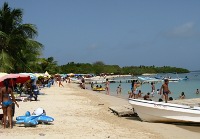 After settling in, we changed into swimsuits, grabbed towels and coolers full of lunch items, and headed off in the cars to a wharf where we were taken on boats to a nearby island for an afternoon of sun, sand, and playing in the water. The older Germans and I stayed in the shade. Food vendors came by constantly, ringing little bells to announce their presence. There was lots of shouting and general silliness, both in and out of the water. Around sunset we returned to the mainland, got cleaned up, and went to one of many outdoor barbecue places near the seafront in a different part of town.
After settling in, we changed into swimsuits, grabbed towels and coolers full of lunch items, and headed off in the cars to a wharf where we were taken on boats to a nearby island for an afternoon of sun, sand, and playing in the water. The older Germans and I stayed in the shade. Food vendors came by constantly, ringing little bells to announce their presence. There was lots of shouting and general silliness, both in and out of the water. Around sunset we returned to the mainland, got cleaned up, and went to one of many outdoor barbecue places near the seafront in a different part of town.
I was sharing a room with S’s sister H, who freaked when the crickets and cockroaches turned up. Any insect had her screaming “Get it out of here!” and “Oh, I won’t be able to sleep with all these insects around.” So my job was to shoo out the crickets and kill the cockroaches… which were typical tropical ones, around 3–5 cm long. I didn’t help by saying, “Oh, they are small ones.”
The Venezuelans, highly amused by all this, retold the cucaracha hunter tale for the new arrivals as the clan gathered. H eventually got in the spirit of things; her version of the story had the cockroaches getting larger with each retelling.
On Sunday (12 July) we were taken by boat to several islands in the nearby Morrocoy National Park. We saw cliffs and a grotto with many statues to one of the saints, and several sand bars (some with trees, some with only beach umbrellas) where people waded around in the shallow water near their anchored boats.
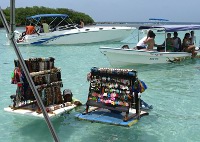 Eventually we arrived at a collection of mangrove islands where many boats were anchored. No sand bars with umbrellas were evident here, but the vendors of food, drink, and souvenirs were wading around doing a brisk trade, and one boat was selling alcoholic beverages including delicious fruit daiquiris.
Eventually we arrived at a collection of mangrove islands where many boats were anchored. No sand bars with umbrellas were evident here, but the vendors of food, drink, and souvenirs were wading around doing a brisk trade, and one boat was selling alcoholic beverages including delicious fruit daiquiris.
Our large group was spread over several boats, one of which had a goodly stock of rum and other goodies for us. Venezuelan rum—yum! (I was later given a bottle as a gift to take home with me.) All the boats with sound systems had them turned up loud. Every time a larger boat with a louder system arrived, the noise increased. I kept reminding myself that it was a cultural experience that I would never otherwise have had, and managed to enjoy it. (No doubt the free-flowing rum helped.)
Again we returned to shore around sunset, cleaned up, and went off for food. Some of the family left to drive home, having to go to work on Monday.
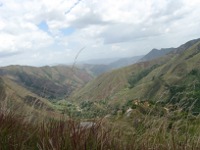 On Monday morning (13 July), most of the remaining locals also went home by the direct route, but two cars carrying the overseas visitors made a side excursion into the mountains to Colonia Tovar, a German village founded in 1843 and isolated from the rest of the country for many years, now a tourist destination. The town itself was only mildly interesting to me, but I very much enjoyed the scenery on the drive in, and then on to Caracas.
On Monday morning (13 July), most of the remaining locals also went home by the direct route, but two cars carrying the overseas visitors made a side excursion into the mountains to Colonia Tovar, a German village founded in 1843 and isolated from the rest of the country for many years, now a tourist destination. The town itself was only mildly interesting to me, but I very much enjoyed the scenery on the drive in, and then on to Caracas.
The last stretch of road into Caracas took us through 15 km of the barrios (slums), mostly mud brick multi-story homes clinging to the steep hillsides. Quite a contrast to the homes of the better-off people in other areas, and a reason for their gates and guards.
Back at D’s uncle’s place, we shared a delicious pasta dinner accompanied by really nice red wine. Afterward, I was taken to the apartment of D’s uncle B, in a different part of the same suburb, where the roads are in better condition and far less crowded. There I was given the daughter’s bedroom for the week. It’s another nice place, in a compound with even more security. In addition to the gate and the guard, everything in the apartment building needs an electronic key: the door to the lift lobby, the lift, the floor buttons on the lift… then there’s the physical key to the barred outer door and another key to the ordinary door. Oddly, the windows don’t have bars or even screens.
Next day (14 July), after doing laundry and email, I enjoyed a yummy meal prepared by B’s wife N. Later she and another relative took D and S and her family and me (and N&B’s three children) to a nearby shopping mall, where we window shopped until the mall closed at 8PM. I saw lots of familiar stores and brand names.
Next day (15 July), some of the family took the overseas guests to Topotepuy, a rainforest reserve on a hill on the outskirts of the city. It was a beautiful place, but rain fell and the weather turned a bit cold for me. I’d brought an umbrella but not a jacket. I recognized many of the plants but had forgotten their names. The plant nursery was particularly interesting (and out of the rain). We had coca tea in the shelter of an outdoor meeting area with what is probably a spectacular view when not obscured by clouds. An Australian cockatoo squawked at us from a cage near the entrance.
We returned to D’s uncle’s apartment for lunch, after which some of the younger people demonstrated their Wii Fit for us (in Spanish). I had not realized how many of the exercise programs were suitable for adults (that is, not totally full of annoyingly cutesy cartoons).
On Thursday (16 July) the family where I was staying took me with them to a nearby mall where the three children got haircuts and back-to-school photos. I’m sure we did something else interesting, but my notes don’t say.
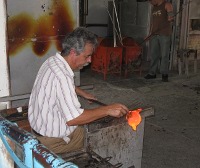 Friday morning (17 July) we visited a glass facÂtory, run by the descendents of people from Murano, Italy (near Venice). I recognized the styles of glass. After watching the glassblowers at work, we admired the results on display in the sales area. Many memÂbers of the group bought items, and I was given a beautiful bird as a guest gift by the family. It was solid and not fragile like many of the items, so it made the trip home in my suitcase without any problem.
Friday morning (17 July) we visited a glass facÂtory, run by the descendents of people from Murano, Italy (near Venice). I recognized the styles of glass. After watching the glassblowers at work, we admired the results on display in the sales area. Many memÂbers of the group bought items, and I was given a beautiful bird as a guest gift by the family. It was solid and not fragile like many of the items, so it made the trip home in my suitcase without any problem.
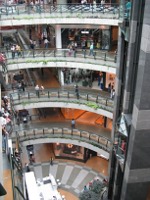 In the afternoon we went to a huge shopping mall somewhere in the city, where we had lunch and various family members shopped while the rest of us wandered about looking at the goods on display. I’m always fascinated by the similarities and differences in stores and goods in shopping malls in the different countries.
In the afternoon we went to a huge shopping mall somewhere in the city, where we had lunch and various family members shopped while the rest of us wandered about looking at the goods on display. I’m always fascinated by the similarities and differences in stores and goods in shopping malls in the different countries.
Saturday (18 July) was Wedding Party Day. Most of us did very little in the morning (conserving our energy for the party). In the afternoon some of us went to a restaurant that served traditional Venezuelan food. It was all well prepared and thoroughly delicious. Chicken and palm and avocado salad, yucca and avocado sauce and a traditional bread. Dessert was sort of like baked custard. One day I may find time to look all this up and see just what the various things were called and what exactly was in them.
We then drove around the city for awhile (stopping briefly at another relative’s place) before returning to the apartment to change into our party clothes and driving to the apartment where the party was being held. Everyone was in formal or semi-formal clothes except the Germans and me. I think most of them like an excuse to dress up. The groom’s purple tie matched the color of the bride’s dress.
Of course the champagne flowed like water, and daiquiris and other drinks were available. The caterers provided an unending supply of yummy finger food (much of which I wasn’t sure I could safely eat, not knowing what was in them), and the bread and cheese platters were heaped with delicious food too. Every available spot in the room had beautiful floral arrangeÂments. The place was so crowded that I couldn’t get many photos. We staggered home in the wee small hours and collapsed, having thoroughly enjoyed it. I gather that the young crowd partied until much later.
On Sunday (19 July) everyone arose late and drove to the cable car station, to go up to the top of the mountain, El Avila. Turns out it was “Children’s Day” and children could take the trip for free (over-60’s could do so, too). So there were many hundreds of people queued up to take the cable car trip. The wait for our turn lasted around 2 hours, giving us more than enough time to observe the locals and have a snack. (I had brought a sandwich and a bottle of water with me, so I didn’t have to take a chance on unfamiliar food.) Everyone, even the children, seemed quite used to waiting in long queues, with people coming and going and saving a place in line for their huge extended families. I spotted a “free wifi” sign but couldn’t test it because I hadn’t brought the iPod with me that day.
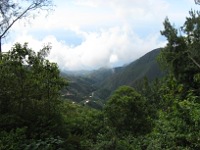 Eventually we got our ride up the mountain (what a view! but hard to photograph from the cable car) and were decanted into a large building full of shops and eateries. We straggled off up the hill towards the viewing places but were soon caught by a change in the weather which dumped huge amounts of rain and brought clouds that obscured everything. Picture 2,000 people all trying to get under cover at once! My umbrella didn’t help much at keeping me dry.
Eventually we got our ride up the mountain (what a view! but hard to photograph from the cable car) and were decanted into a large building full of shops and eateries. We straggled off up the hill towards the viewing places but were soon caught by a change in the weather which dumped huge amounts of rain and brought clouds that obscured everything. Picture 2,000 people all trying to get under cover at once! My umbrella didn’t help much at keeping me dry.
The rain and clouds looked like continuing for the rest of the day, so after a lot more milling around, the family decided to get in the queue to go back down again. They took turns holding places while groups went off to eat. Two hours or so later, we finally got into a car and went down again. On the way home, we stopped at a fast-food place, and in the evening I washed clothes (in preparation for flying to Peru the next day). It was the kind of day that would normally annoy me greatly, but I found the “cultural experience” aspect sufficiently interesting to keep me from the grumps.
In the early afternoon of Monday (20 July) two cars took the overseas guests down the mountain to the airport. My flight was several hours after the Germans’, so I had a leisurely time to check in and wander around the airport a bit before going to the business-class lounge. Before check-in I first discovered the South American enthusiasm for shrink-wrapping one’s luggage in an effort to protect it from accidental damage and deliberate theft of contents.
This time the airline’s lounge had no real food, and the flight was an hour late leaving, so I was a bit hungry by the time we were airborne and the food service began.
